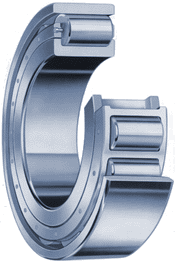

Balisong knives are a fine balancing act... in more than one way.
If the joints to tight, the knife will be difficult or impossible to manipulate. But, if they're to loose, there will be to much blade play and wobble making the knife difficult to manipulate. A knife maker has to find the perfect balance between tight and loose.
The problem is friction. Inside of a balisong joint, there are two sources of friction. The first is where the inside of the hole in the blade rubs against the pin. The second is where the side of the blade rubs against the inside of the handles.
Previous makers have addressed friction with the pin by including a solid bushing. Microtech's Tachyon is one example (click here to see a Microtech Tachyon disassembled). This creates two moving interfaces. (For you engineer-types, this creates two resistances in parallel.) Add a little lubricant and it's even better since we now have two layers of lubrication.
Some custom makers have even tried roller bearings.
As used in this article, the term "roller bearing" refers to an assembly consisting of two concentric rings with some sort of bearings, usually ball bearings or pin bearings, between them. This picture from from The Torrington Company illustrates a typical roller bearing:

Roller bearings are great when a rotating shaft passes straight through a solid block. But, when other forces are added, as they are when manipulating a balisong, roller bearings experience tremendous stress. The bearings end up compressed between the two rings and can be literally ground to powder.
Roller bearings small enough to fit inside balisong joints are precision sub-assemblies. As a result, they're very expensive. And if they have to be strong enough to withstand the forces in a balisong, then they get even more expensive.
I've manipulated balisongs with roller bearings and I've gotta tell you: they're not worth the price.
Why?
Simple: there are two sources of friction inside the joints of a balisong. Roller bearings only address friction between the inside of the blade hole and the pin. Roller bearings don't address friction between the sides of the blade and the handles. Since the surface area involved in the later case is much greater, it contributes most of the friction. Roller bearings only address the minor problem.
Furthermore, roller bearings do little to reduce blade wobble and play.
Look at the joints on Cold Steel's Arch Angel:
Notice how tight that is. It almost looks like the blade and the handle are one piece of metal.
Roton's new Monarch is even more dramatic.
Monarch can get away with such tight joints and still have the joint move because the handles and the blade are precision machined.
Tachyon, well-known for smooth joints with minimal blade-play, looks very tight:
Tachyon's golden-colored Phosphor-bronze washers let you know that the handles and the blade are not one solid piece. Washers in balisong joints are very common. They're an attempt to fight friction between the side of the blade and the inside of the handles. Like bushings did for the junction of the pin and the blade, washer add a second interface between the handles and the side of the blade (again, it becomes two resistances in parallel).
Now, look at Korth's joint:
WOW! Look at those gaps!
At first glance, you might expect a lot of play and slop in these joints. You'd expect that blade to wobble back and forth horribly and be very difficult to control.
But, it just isn't so. Despite those huge gaps, despite the fact that the blade does not even touch the insides of the handles, there is NO play, no wobble, NONE!
How can that be?
The answer is Patent-Pending:
Do you see them in there? There are ball bearings inside these joints!
It's called the "Ikoma-Korth bearing system," and it's patent-pending.
Ikoma is Flavio Ikoma, another Brazilian knife maker, who contributed to the development of this patent-pending bearing system. Mr. Ikoma makes conventional folding knives and his work, with the "Ikoma Handmade Knives" stamp, is popular in Brazil, and rapidly gaining international recognition.
The Ikoma-Korth bearing system is not a roller bearing. These ball bearings are between the sides of the blade and the sides of the handle. Thus, they address the major source of friction: friction between the sides of the blade and the inside of the handle. The The Ikoma-Korth bearing system allow the joint to be as tight as possible and yet still rotate freely. That translates into free rotation with no wobble. And that translates into smooth manipulation.
The inside of the hole in the blade still rides direction on the pivot pin. But that's by far the minor friction source in a balisong joint and it's not the cause of blade wobble.
With a revolutionary design like this, two questions come up:
First) Does it work? The answer is a resounding yes! This Korth prototype feels like no other balisong I've ever manipulated. It's as if the blade is floating between the handles. It's totally smooth.
Second) Is it durable? That was my big question so I insisted on almost a month to play with this knife and put hours of manipulation on it. As far as I can tell, it held up perfectly.
Will the little balls wear out? Eventually, yes they probably will. If they do, you can easily and inexpensively replace them.
With the patent-pending Ikoma-Korth bearing system, Korth has solved the problem of how to make a balisong joint that rotates freely with no wobble or blade play.
All I can say is: Bravo!
Korth is currently taking orders. If you'd like one of these extraordinary balisongs, contact Korth's dealer, Mr. Mauro Machado, at Taymo Knives in Campinas, Brazil, http://www.taymo.com.